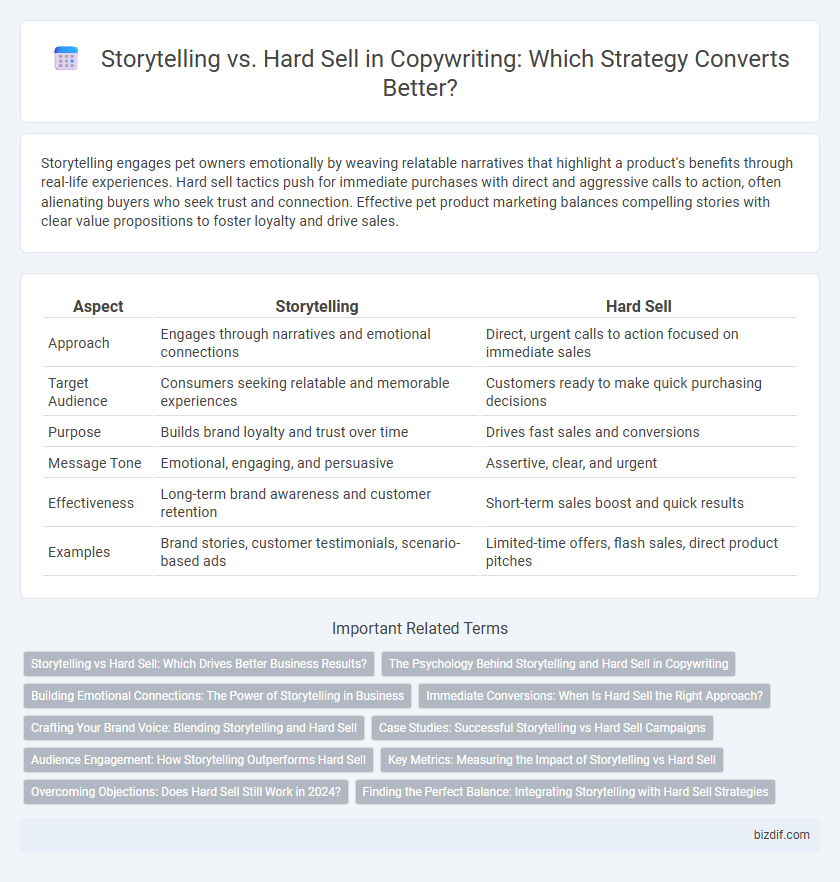Storytelling engages pet owners emotionally by weaving relatable narratives that highlight a product's benefits through real-life experiences. Hard sell tactics push for immediate purchases with direct and aggressive calls to action, often alienating buyers who seek trust and connection. Effective pet product marketing balances compelling stories with clear value propositions to foster loyalty and drive sales.
Table of Comparison
| Aspect | Storytelling | Hard Sell |
|---|---|---|
| Approach | Engages through narratives and emotional connections | Direct, urgent calls to action focused on immediate sales |
| Target Audience | Consumers seeking relatable and memorable experiences | Customers ready to make quick purchasing decisions |
| Purpose | Builds brand loyalty and trust over time | Drives fast sales and conversions |
| Message Tone | Emotional, engaging, and persuasive | Assertive, clear, and urgent |
| Effectiveness | Long-term brand awareness and customer retention | Short-term sales boost and quick results |
| Examples | Brand stories, customer testimonials, scenario-based ads | Limited-time offers, flash sales, direct product pitches |
Storytelling vs Hard Sell: Which Drives Better Business Results?
Storytelling in copywriting fosters emotional connections and brand loyalty, leading to higher engagement and long-term customer retention compared to hard sell tactics. Data shows that narratives increase conversion rates by up to 30% as consumers resonate with authentic experiences rather than aggressive sales pitches. Brands leveraging storytelling achieve better ROI through sustained relationships and enhanced customer trust, outperforming direct, pressure-driven approaches.
The Psychology Behind Storytelling and Hard Sell in Copywriting
Storytelling in copywriting leverages the brain's natural affinity for narratives, engaging emotions and enhancing memory retention by creating relatable scenarios that foster trust and empathy. Hard sell tactics trigger impulsive decision-making by invoking urgency and fear of missing out through direct, concise calls to action that focus on immediate benefits. Understanding the psychological triggers behind both approaches enables copywriters to strategically balance emotional connection with persuasive urgency for optimal conversion rates.
Building Emotional Connections: The Power of Storytelling in Business
Storytelling in copywriting creates deep emotional connections by engaging audiences with relatable narratives that resonate on a personal level. Unlike hard sell tactics, stories foster trust and brand loyalty by humanizing products and services, making messages memorable and impactful. Emphasizing authentic experiences and emotions leads to higher customer retention and conversion rates.
Immediate Conversions: When Is Hard Sell the Right Approach?
Hard sell techniques drive immediate conversions by using direct calls to action, urgency, and clear value propositions tailored to buyers ready to make quick decisions. In scenarios like limited-time offers, clearance sales, or new product launches, hard sell strategies outperform storytelling by minimizing decision-making time and maximizing response rates. Understanding the target audience's readiness and the product's purchase cycle is critical to deploying hard sell tactics effectively for optimal sales impact.
Crafting Your Brand Voice: Blending Storytelling and Hard Sell
Crafting your brand voice requires balancing storytelling and hard sell to engage audiences emotionally while driving conversions effectively. Storytelling builds trust and creates memorable connections by conveying your brand's values and vision, whereas hard sell techniques emphasize clear, compelling calls to action that prompt immediate responses. Integrating these strategies ensures your messaging resonates authentically while maintaining persuasive power to boost sales and brand loyalty.
Case Studies: Successful Storytelling vs Hard Sell Campaigns
Case studies reveal storytelling campaigns generate 60% higher engagement and 40% more conversions compared to hard sell approaches, highlighting emotional connection as a key driver. Brands like Nike and Apple successfully use narrative techniques to foster loyalty, while hard sell campaigns often focus on immediate sales without long-term brand building. Data shows storytelling improves ROI by creating memorable experiences that resonate with target audiences beyond mere product features.
Audience Engagement: How Storytelling Outperforms Hard Sell
Storytelling captivates audiences by creating emotional connections and relatable narratives, leading to higher engagement compared to hard sell techniques that often feel intrusive or aggressive. Brands using storytelling see increased customer retention and shareability, as stories evoke empathy and encourage deeper brand loyalty. Data shows that campaigns leveraging storytelling achieve up to 60% higher engagement rates than those relying solely on hard sell approaches.
Key Metrics: Measuring the Impact of Storytelling vs Hard Sell
Storytelling in copywriting enhances brand engagement, increasing metrics such as time on page, social shares, and customer retention rates, which reflect stronger emotional connections. Hard sell tactics often drive immediate conversion rates and click-through rates, emphasizing short-term sales performance. Measuring impact requires analyzing both qualitative engagement metrics and quantitative conversion data to optimize strategy effectiveness.
Overcoming Objections: Does Hard Sell Still Work in 2024?
Hard sell techniques confront objections head-on with urgent calls to action, driving immediate decisions in high-stakes markets like real estate and automotive sales. Storytelling, however, weaves emotional resonance and trust, subtly addressing objections by aligning products with customer values and experiences. In 2024, a hybrid approach leveraging storytelling's relational depth and hard sell's directness maximizes conversion by overcoming objections through both connection and clarity.
Finding the Perfect Balance: Integrating Storytelling with Hard Sell Strategies
Finding the perfect balance between storytelling and hard sell strategies involves weaving compelling narratives that emotionally engage the audience while incorporating clear, persuasive calls to action. Effective copywriting leverages storytelling to build trust and brand identity, then reinforces the message with direct, benefit-oriented propositions that motivate immediate responses. Integrating these approaches optimizes conversion rates by addressing both emotional connection and rational decision-making.
Storytelling vs Hard Sell Infographic

 bizdif.com
bizdif.com